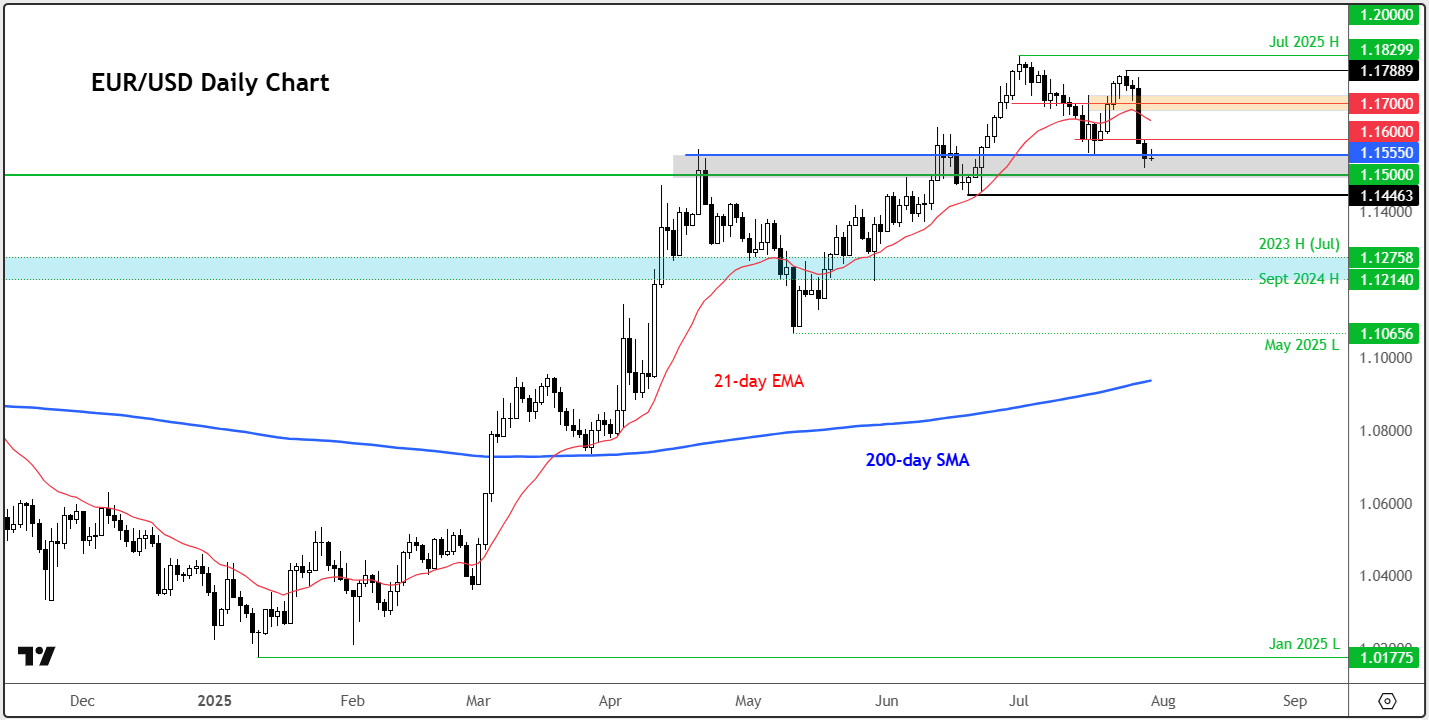United Homes Group stock plunges after Nikki Haley, directors resign
- Euro weakens despite upbeat GDP and trade optimism; focus shifts to US data and Fed.
- EUR/USD holds key support; traders await FOMC tone and fresh rate-cut signals.
- High beta names rise, but oil and geopolitical risks keep dollar sentiment supported.
-
Looking for actionable trade ideas? Subscribe now to unlock access to InvestingPro’s AI-selected stock winners for up 50% off amid the summer sale!
Following Monday’s drop, we saw European markets bounce back on Tuesday and were holding steady in today’s first half of the session. Trade deal optimism and better-than-expected results from European companies soothed investor concerns ahead of big US tech earnings this week. And with that, you’d expect the risk-sensitive commodity dollars to back.
But they have extended their slide against the US dollar instead. The EUR/USD has also weakened further ahead of the release of US GDP data later today and other key macroeconomic events throughout the week. Today’s main focus will be on the FOMC rate decision. These events have the potential to impact the EUR/USD direction, although much of the attention remains on trade negotiations.
Not Much to Cheer for Euro Investors Over Trade Deal
The US Dollar Index has shown some signs of life this month after repeatedly coming under pressure due to multiple factors, ranging from the impact of tariffs to fiscal uncertainties and concerns about US creditworthiness. But some of those concerns have eased with the US managing to strike trade agreements with the European Union and Japan.
Markets were expecting a deal to be reached between the EU and the US, so when the news emerged at the weekend, we saw an initial spike higher in index futures. But then we saw investors take profit in a classic ‘buy the rumour, sell the fact’ market reaction.
The fact that markets have bounced back suggests investors have been buoyed by hopes that the US-EU trade accord might draw a line under recent uncertainty, offering European businesses a clearer path forward. But the euro’s reaction to the news, however, wasn’t great. FX investors — and indeed several European leaders — appeared to reach the view that, on balance, broad-based tariffs would be more of a burden than a boon.
So, while the EU has prevented an imminent trade war with the US, critics argue that the deal is bad for the EU and will cause inflation to rise in the US. Accordingly, the EU will seek to expand on some of the elements negotiated over the weekend, according to reports. This may mean more delays before signing a deal.
Still, once the dust settles, the inclusion of key sectors such as pharmaceuticals and semiconductors under the 15% tariff bracket may be interpreted as something of a silver lining. For now, Europe may simply have to press on, perhaps with renewed attention to bolstering domestic demand.
And then there are the ongoing US-China trade talks. Officials from Beijing and Washington are trying to extend their tariff truce beyond a mid-August deadline, in an effort to find ways to maintain trade ties while safeguarding economic security.
Eurozone GDP Beats, but Does It Matter?
The EUR/USD exchange rate held below the $1.16 handle following news that the euro area economy managed to eke out modest 0.1% growth in the second quarter following a 0.6% growth in the first. The data was still slightly better than expected, thanks to France (+0.3%) and Spain (+0.7%) leading the charge.
Meanwhile, Germany (-0.1%) and Italy (-0.1%) both contracted as expected. The modest Eurozone GDP surprise is unlikely to shift the European Central Bank’s stance in any meaningful way. For the time being, the market’s gaze remains fixed on the implications of the recent trade agreement with the United States and what it may herald for growth in the coming quarters.
FOMC – Holding Pattern With an Eye on September
All eyes now turn to the Federal Reserve, where Chair Jerome Powell is expected to subtly pave the way for a potential rate cut in September. However, the message will almost certainly be couched in conditionality—data will remain the guide. A weaker labour market or subdued inflation could provide the impetus for easing, while stronger prints might well push any move further out.
At present, markets are pricing in roughly a 70% chance of a September cut. Nonetheless, expectations for this evening’s decision are subdued. Rates will almost certainly be left unchanged. Dissent is anticipated from Waller and possibly Bowman. With no updated Summary of Economic Projections on offer, Powell will likely stick to his usual refrain: data dependency.
But will there be any surprises? Well, the biggest shocker would be Waller voting to hold rates — a clear hawkish signal likely to send the dollar sprinting ahead. On the dovish side, a third dissenter voting for a cut would also surprise.
The implications for the EUR/USD are significant. Any dovish tilt from the Fed could weaken the US dollar and bolster the appeal of the world’s most popular currency pair. Conversely, if the central bank maintains a hawkish stance in the face of stubborn inflation, the single currency may face fresh resistance as the dollar and yields find support.
Don’t Forget the US Data and Oil Prices
In addition to the Fed, a slate of important US economic data is on the docket. GDP data is coming up shortly, while the non-farm payrolls report is due on Friday. These numbers could either reinforce or challenge the current policy narrative — and will certainly factor into short-term movements in both the dollar and yields.
It is also worth keeping an eye on the energy markets, where President Trump’s decision to bring forward the deadline for Russia to agree to a ceasefire has ever so slightly heightened the prospect of secondary sanctions being imposed on foreign purchasers of Russian crude — namely China, India, and Turkey. Any resultant spike in oil prices, driven by fears of Russian supply being curtailed from the global market, would likely weigh on the euro and lend support to the US dollar.
EUR/USD: Key Levels to Watch
Despite Monday’s big drop and the follow-up selling on Tuesday, it is far too early to suggest the EUR/USD trend has turned bearish from a technical perspective. That’s because all the major support levels remain intact. The most important area of support for me is between 1.1500 to 1.1570ish, where the EUR/USD has previously found both support and resistance in the past.
The bears will need to push rates below this zone to cause a dent in the still-bullish market structure. Below this area, the next key battleground is between 1.1210-1.1275, meaning there is a fair bit of ground to make for the bears.
On the upside, 1.1600 is now the first level of resistance to watch. Above it there is not much further resistance seen until we get near the 1.1700 area.
***
Whether you’re a novice investor or a seasoned trader, leveraging InvestingPro can unlock a world of investment opportunities while minimizing risks amid the challenging market backdrop.
- ProPicks AI: AI-selected stock winners with proven track record.
- InvestingPro Fair Value: Instantly find out if a stock is underpriced or overvalued.
- Advanced Stock Screener: Search for the best stocks based on hundreds of selected filters, and criteria.
- Top Ideas: See what stocks billionaire investors such as Warren Buffett, Michael Burry, and George Soros are buying.

Disclaimer: This article is written for informational purposes only; it does not constitute a solicitation, offer, advice, counsel or recommendation to invest as such it is not intended to incentivize the purchase of assets in any way. I would like to remind you that any type of asset, is evaluated from multiple perspectives and is highly risky and therefore, any investment decision and the associated risk remains with the investor.
Read my articles at City Index
